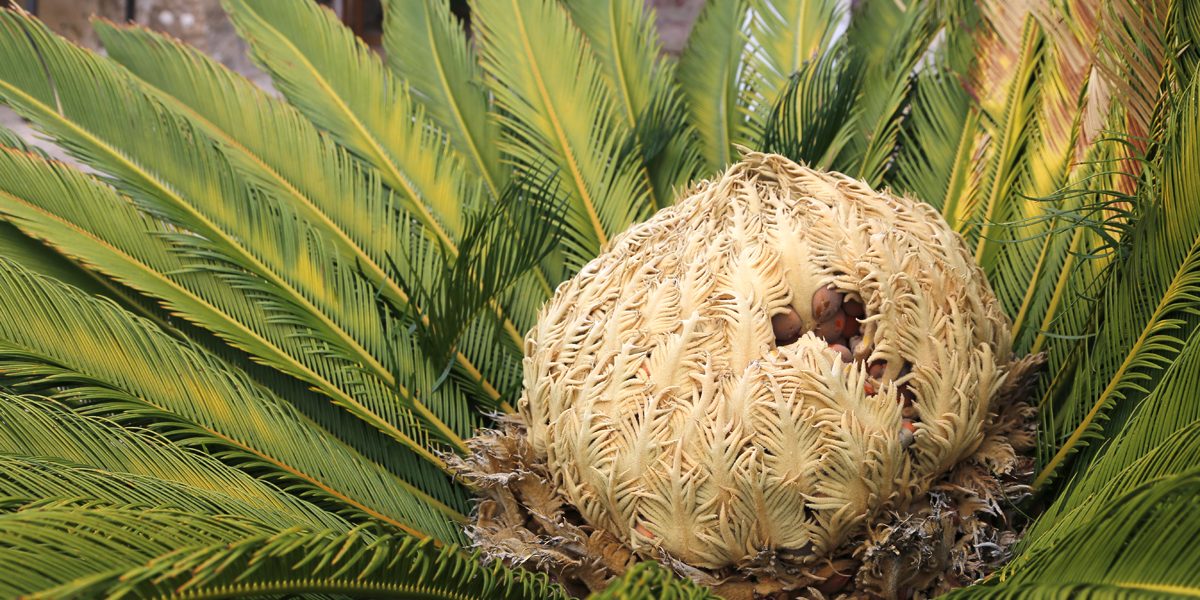Sago palms feature a thick and hairy trunk, with feathery leaves. The Sago tends to thrive in USDA zone 7. They can deal with a bit of cold weather, but would rather live in warm areas.
Sago palms can live for up to one hundred years. They are slow-growing and will usually produce one new frond each and every year. These palms come from the tropical plant family called Cycas, complete with forty species. However, these palms can suffer from a few problems, which are detailed below.
Most Common Sago Palm Problems
Dealing with these common issues does not mean your palm will eventually die. If you can properly identify the problems and know how to care for the plant, you can ultimately save your sago palm. Let’s take a look at the most common problems.
Yellowing
Yellowing in sago palms is quite common in older leaves that are about to drop to the ground. This yellowing in younger leaves can be caused by a lack of manganese within the soil.
Apply manganese sulfate powder to your soil two to three times each year to correct this issue. Subsequent growth should produce healthy, green leaves.
Pests
Common sago palm pests will include mealybugs and scale. Mealybugs are fuzzy white bugs which feed upon stems and plant fruits. These bugs will reproduce and spread rapidly, so it’s recommended to take care of this issue immediately.
Try applying a strong spray of water and/or insecticidal soap to wash the pests away. If the Mealybug population gets out of control, then you may be forced to throw away your sago palm.
Root Rot
Phytophthora fungi will invade the roots and root crowns, eventually causing root rot. This will result in discoloration, wilt and leaf drop.
You can identify this issue when seeing a dark vertical stain or sore on the trunk. Make sure to never overwater your palm in a good draining soil.
How To Care For A Sago Palm Tree
Sago palms (Cycas revoluta) add a beach like, somewhat primitive, focal point to your landscaping. Even though the large fronds are comparable of palms, Sagos palms are surprisingly cycads and more closely related to conifer trees.
Sago palms grow in USDA plant hardiness zones 8 through 10. A mature plant can sometimes reach up to 10 feet tall when cared for properly.
Site Requirements
Even though Sago palms can grow in full sun, they grow best in moderately shaded areas. Too much sunlight results in sunburnt foliage and can stress the Sago palm. Partial shade allows the leaves to grow larger, making the plant bigger. Sago palms also require well-drained soil.
Waterlogged conditions can result in rot problems, but the soil must keep enough moisture, so it doesn’t dry too fast. A partially sandy site added with organic matter, like compost, will work well.
Watering
Sago palms need to be watered only when the soil starts to dry out. Younger Sago palms benefit from regular irrigation, so the soil doesn’t completely dry out.
Watering every 5 to 7 days when there is little to no rainfall and supplying enough to moisten the top 12 inches of soil is adequate. Plants that are well established are drought-resistant and require watering very rarely.
Fertilizing Your Sago
Adding an annual application of a slow-release, balanced fertilizer in spring will usually supply enough nutrients. Sprinkle around 1 tablespoon per square foot of a 10-10-10 fertilizer recipe around the base of the Sago, at least 8 inches from the palm and water it in.
Yellow foliage can indicate a potassium or magnesium shortage in the soil. Chelated iron spray on the foliage will provide these necessary nutrients. Older foliage may stay yellow, but the new foliage will grow a healthy green.
Pruning Your Sago
Pruning is only necessary for aesthetics. You can remove the cone from the center of the Sago carefully, but try not to damage the growing point beneath it.
If it is left in place, the cone will break apart and fall off on its own as new foliage takes over. If the old foliage becomes tattered, cut them off close to the trunk after new leaves have entirely unfolded.
Treating A Sick Sago
Once you have figured out why the Sago palm is yellowing, you will need to know how to treat sick Sago palms effectually. When there are nutritional deficiencies, try feeding Sago palms houseplant fertilizer around once a month.
Regular balanced fertilizer is essential for the healthy maintenance of Sago palms. If you Sago palm is indoors and scale infestations are a problem, you can try hand picking them off or placing them outdoors and allow their natural predators to help eliminate them.

If you’re ready to choose and have a pomegranate tree planted at your Mesa home contact the knowledgeable and helpful folks at your local A&P Nursery.





